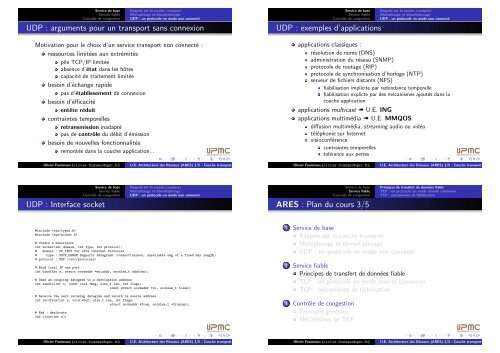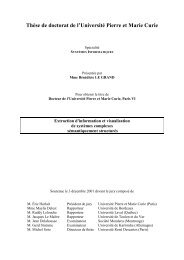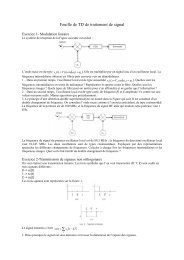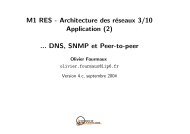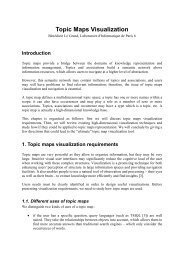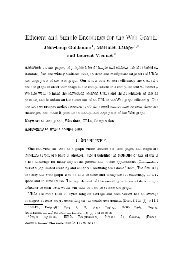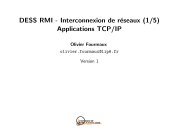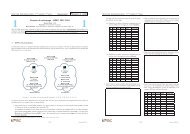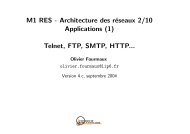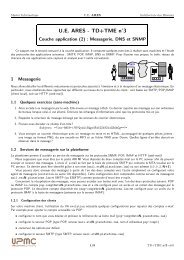U.E. Architecture des Réseaux (ARES) 3/5 : Couche transport
U.E. Architecture des Réseaux (ARES) 3/5 : Couche transport
U.E. Architecture des Réseaux (ARES) 3/5 : Couche transport
You also want an ePaper? Increase the reach of your titles
YUMPU automatically turns print PDFs into web optimized ePapers that Google loves.
Service de base<br />
Service fiable<br />
Contrôle de congestion<br />
Rappels sur la couche <strong>transport</strong><br />
Multiplexage et démultiplexage<br />
UDP : un protocole en mode non connecté<br />
UDP : arguments pour un <strong>transport</strong> sans connexion<br />
Service de base<br />
Service fiable<br />
Contrôle de congestion<br />
UDP : exemples d’applications<br />
Rappels sur la couche <strong>transport</strong><br />
Multiplexage et démultiplexage<br />
UDP : un protocole en mode non connecté<br />
Motivation pour le choix d’un service <strong>transport</strong> non connecté :<br />
ressources limitées aux extrémités<br />
pile TCP/IP limitée<br />
absence d’état dans les hôtes<br />
capacité de traitement limitée<br />
besoin d’échange rapide<br />
pas d’établissement de connexion<br />
besoin d’éfficacité<br />
entête réduit<br />
contraintes temporelles<br />
retransmission inadapté<br />
pas de contrôle du débit d’émission<br />
besoin de nouvelles fonctionnalités<br />
remontés dans la couche application...<br />
applications classiques :<br />
résolution de noms (DNS)<br />
administration du réseau (SNMP)<br />
protocole de routage (RIP)<br />
protocole de synchronisation d’horloge (NTP)<br />
serveur de fichiers distants (NFS)<br />
fiabilisation implicite par redondance temporelle<br />
fiabilisation explicte par <strong>des</strong> mécanismes ajoutés dans la<br />
couche application<br />
applications multicast ➠ U.E. ING<br />
applications multimédia ➠ U.E. MMQOS<br />
diffusion multimédia, streaming audio ou vidéo<br />
téléphonie sur Internet<br />
visioconférence<br />
contraintes temporelles<br />
tolérance aux pertes<br />
Olivier Fourmaux (olivier.fourmaux@upmc.fr)<br />
U.E. <strong>Architecture</strong> <strong>des</strong> Réseaux (<strong>ARES</strong>) 3/5 : <strong>Couche</strong> <strong>transport</strong><br />
Olivier Fourmaux (olivier.fourmaux@upmc.fr)<br />
U.E. <strong>Architecture</strong> <strong>des</strong> Réseaux (<strong>ARES</strong>) 3/5 : <strong>Couche</strong> <strong>transport</strong><br />
Service de base<br />
Service fiable<br />
Contrôle de congestion<br />
Rappels sur la couche <strong>transport</strong><br />
Multiplexage et démultiplexage<br />
UDP : un protocole en mode non connecté<br />
Service de base<br />
Service fiable<br />
Contrôle de congestion<br />
Principes de transfert de données fiable<br />
TCP : un protocole en mode orienté connexion<br />
TCP : mécanismes de fiabilisation<br />
UDP : Interface socket<br />
<strong>ARES</strong> : Plan du cours 3/5<br />
#include <br />
#include <br />
# Create a <strong>des</strong>criptor<br />
int socket(int domain, int type, int protocol);<br />
# domain : PF_INET for IPv4 Internet Protocols<br />
# type : SOCK_DGRAM Supports datagrams (connectionless, unreliable msg of a fixed max length)<br />
# protocol : UDP (/etc/protocols)<br />
# Bind local IP and port<br />
int bind(int s, struct sockaddr *my_addr, socklen_t addrlen);<br />
# Send an outgoing datagram to a <strong>des</strong>tination address<br />
int sendto(int s, const void *msg, size_t len, int flags,<br />
const struct sockaddr *to, socklen_t tolen);<br />
# Receive the next incoming datagram and record is source address<br />
int recvfrom(int s, void *buf, size_t len, int flags,<br />
struct sockaddr *from, socklen_t *fromlen);<br />
# End : dealocate<br />
int close(int s);<br />
1 Service de base<br />
Rappels sur la couche <strong>transport</strong><br />
Multiplexage et démultiplexage<br />
UDP : un protocole en mode non connecté<br />
2 Service fiable<br />
Principes de transfert de données fiable<br />
TCP : un protocole en mode orienté connexion<br />
TCP : mécanismes de fiabilisation<br />
3 Contrôle de congestion<br />
Principes généraux<br />
Mécanismes de TCP<br />
Olivier Fourmaux (olivier.fourmaux@upmc.fr)<br />
U.E. <strong>Architecture</strong> <strong>des</strong> Réseaux (<strong>ARES</strong>) 3/5 : <strong>Couche</strong> <strong>transport</strong><br />
Olivier Fourmaux (olivier.fourmaux@upmc.fr)<br />
U.E. <strong>Architecture</strong> <strong>des</strong> Réseaux (<strong>ARES</strong>) 3/5 : <strong>Couche</strong> <strong>transport</strong>


